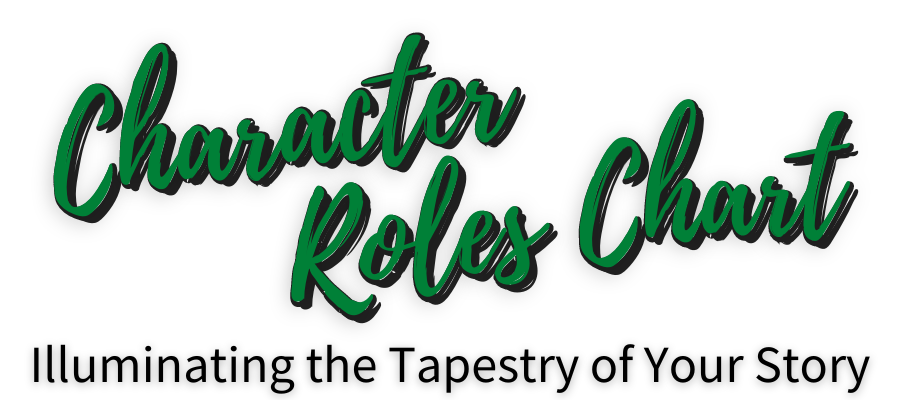
In the grand tapestry of storytelling, characters are the threads that weave through every plot twist and narrative arc.
Let’s dive into the world of Character Roles Charts – a powerful tool that not only helps authors keep track of their characters but also engages readers in a dynamic exploration of the roles each character plays in the unfolding story.
Creating Your Character Roles Chart
Embark on this creative journey by crafting a Character Roles Chart. Visualize the relationships and dynamics between characters, arranging them in a way that reflects their roles in the narrative. This could be a family tree-style chart, a matrix, or any format that resonates with your storytelling.
Example:
Chart Title: “Dance of Characters in [Book Title]”
- Family tree-style arrangement showcasing character relationships.
- Color-coded sections highlighting different character roles.
To help you get started, use this ready-made template. Like this:

Defining Character Roles
Assign clear roles to each character in your chart. From protagonists and antagonists to supporting characters and mentors, let each role be a beacon guiding readers through the narrative landscape.
Example:
Character Role: “Eleanor Grace”
- Protagonist’s best friend
- Occasional comic relief
- Catalyst for crucial plot developments
Interactive Digital Versions
Consider creating an interactive digital version of your Character Roles Chart. Host it on your author website, allowing readers to explore and click on each character to reveal more details about their roles. This adds a layer of engagement to the reading experience.
Example:
Digital Chart Feature: “Explore Character Roles”
- Clickable links or pop-ups for each character with additional role insights.
Character Role Insights
Elevate your Character Roles Chart by providing insights into each character’s role. Offer brief snippets or anecdotes that give readers a glimpse into the impact each character has on the overall narrative.
Example:
Role Insight: “Eleanor Grace”
- Role: Protagonist’s confidante and ally
- Key Moments: Moments of comic relief, pivotal decisions influenced by Eleanor
Reader Engagement Prompts
Encourage reader engagement by prompting them to interact with the Character Roles Chart. Ask questions about their favorite character roles, or invite them to share their interpretations and predictions based on the chart.
Example:
*Reader Engagement Prompt: “Which character’s role surprised you the most? Share your thoughts in the comments!”
Conclusion
A Character Roles Chart isn’t just a visual aid; it’s an invitation for readers to dive deeper into the intricate relationships and dynamics that shape your narrative world. By incorporating this tool into your storytelling arsenal, you not only keep your narrative organized but also create a bridge that connects readers to the heart of your characters’ journeys.
Let your amazing characters dance across your chart and lead your readers on a captivating journey through the roles that define your story.

What to Include on Your Character Roles Chart
To fill out this chart, please think about what roles your characters play within your story. Here’s what you could include:
- Name (first and last)
- Family dynamic to main characters (mother, father, sister, brother, cousin, etc.)
- Relationship to other characters (best friend, frenemy, enemy, arch-nemesis, etc.)
- Role in the story (protagonist, antagonist, contagionist, tangoist, etc.)
- Type of character (primary, secondary, tertiary, etc.)
- Evolution of character (dynamic or static)
- Characterization of character (round or flat)
- Unique characteristics (soft-hearted, alpha male, bold, loves animals, strong female, etc.)
While this is not a full list, it is different than the Character Names Chart. The Character Roles Chart is all about what role your characters play in the story!
What are some fun ways to enhance your Character Roles Chart?
Once you’ve added the basic info for your chart, you can make it more interesting by adding fun graphics or even photos each of your characters. This is definitely not necessary but it’s a nice touch if you want to go above and beyond for your reader fans and give them something extra special that other authors may be be doing.
It will also help them connect with the characters even more which will only serve to increase their enjoyment of reading your book!
Build Your Own
Create Your Own Character Roles Chart
It’s a small price to pay for a valuable content idea you can share with your readers.
And what’s fun, it can be used for every one of your books or book series!

What’s Next…
Want a deeper look into how to create content that’s entertaining, educational, engaging, inspiring, and persuasive.
Still wondering about the benefits of offering quality content? Take a look at this article.
Make sure to add the essential content elements to your author platforms!
If you’re ready to take your website to the next level, check out how you can Build Your Own Content Library and pick a content template that fits your readers.
Check out the Ultimate Guide to Building your Content to get tips on how to do-it-yourself!
